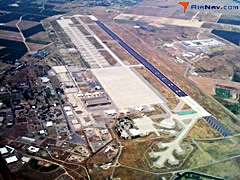 The U.S. Forest Service entered into a five-year contract – ushered in bythe massive Rim fire in Stanislaus National Forest – with Merced County for use of Castle Airport in Atwater.
The U.S. Forest Service entered into a five-year contract – ushered in bythe massive Rim fire in Stanislaus National Forest – with Merced County for use of Castle Airport in Atwater.
Flight and ground crews hit the ground running Tuesday, their first day at Castle Airport, as they filled air tankers with flame retardant.
The blaze has spread to 192,466 acres, making it the sixth-largest fire in California history.
Dave Campodonico, the air tanker base manager, said Castle Airport was a practical choice for a Forest Service location. The base can handle the size and weight of a DC-10.
“We have, kind of, a tanker-base system with different airports,” he said, adding the next closest are in Fresno and Stockton.
Campodonico said the Forest Service and Merced County had been in discussions for some time, and the Rim fire sped up the process.
Ideally, Castle will handle the largest tankers, the DC-10, while other bases can load the others, like the C-130.
When a fire is not burning, the Castle Airport base’s crew will not be stationed there on a daily basis, Campodonico said, but the site will be used depending on fire proximity.
Campodonico said the most vulnerable points needing protection right now are the Hetch Hetchy Reservoir, Tuolumne City and a number of smaller communities.
“We pounded a lot of retardant to protect these areas,” Campodonico said, adding retardant allows firefigher crews to get in to squash the flames.
The steepness of the canyon where the fire started made fighting the flames difficult. “It’s almost vertical. It’s almost a cliff,” Campodonico said.
The Rim fire has destroyed 111 structures, including 31 homes, and posed a threat to giant sequoias. More than 4,500 firefighters are battling the blaze.
Cameron Jones, assistant base manager for the Forest Service at Castle, said each day’s needs are different, but air tanker pilots begin their runs in the early afternoon and continue until 30 minutes before sundown.
The air tankers can carry about 11,600 gallons of medium-viscosity retardant to the Rim fire, Jones said, and the base turns them around about every 40 minutes. So, they make five or six trips a day.
The Rim fire started Aug. 17 and quickly exploded in size. Its progression slowed earlier this week when it moved from parts of the forest with thick underbrush that had not burned in nearly a century to areas that had seen fire in the past two decades.
But it will likely burn for months, possibly until California’s dry season ends this fall.
“My prediction is it will burn until we see rain,” said Hugh Safford, a regional ecologist with the U.S. Forest Service.
That means the smoke could continue to foul air north of Yosemite in the Lake Tahoe basin and neighboring Nevada.
The Merced County Department of Public Health released a smoke and air quality warning for residents on Wednesday.
“Wildfire smoke has harmful chemicals that can affect your health,” Public Health Director Kathleen Grassi said in a news release. “It can cause eye and throat irritation, coughing, and difficulty breathing.
It can also exacerbate the symptoms of asthma.
Grassi said residents who smell or see smoke should minimize or stop outdoor activities, especially exercise, and stay indoors with windows and doors closed.
People at the greatest risk of symptoms associated with wildfire smoke are those with respiratory disease or heart disease, young children and older adults, the release stated.
Anyone with chronic health conditions should closely monitor their health, and should seek medical help if symptoms are persistent or worsen, the release stated.
Mark Hendrickson, director of commerce, aviation and economic development for Merced County, said county and Forest Service officials had been in discussions for years about using Castle Airport.
“We’ve been working with the U.S. Forest Service for quite some time, trying to establish Castle as a place from which they could launch operations of this nature, obviously for firefighting purposes,” he said.
Under the agreement, Merced County will charge the Forest Service through a series of fees: $225 per month for the 5,200-square-foot building lease, $450 per day for the 551,600-square-foot ramp and 50 cents per 1,000 pounds a plane weighs upon landing, according to county staff.
The county will also charge for the use of water and utilities.
Fighting the fire shows off Castle Airport’s ability to handle large jets, Hendrickson said, and be a cog in the public-safety machine.
“Anytime that you have an airport able to exercise its capabilities, it’s a good marketing tool for future opportunities,” Hendrickson said.
